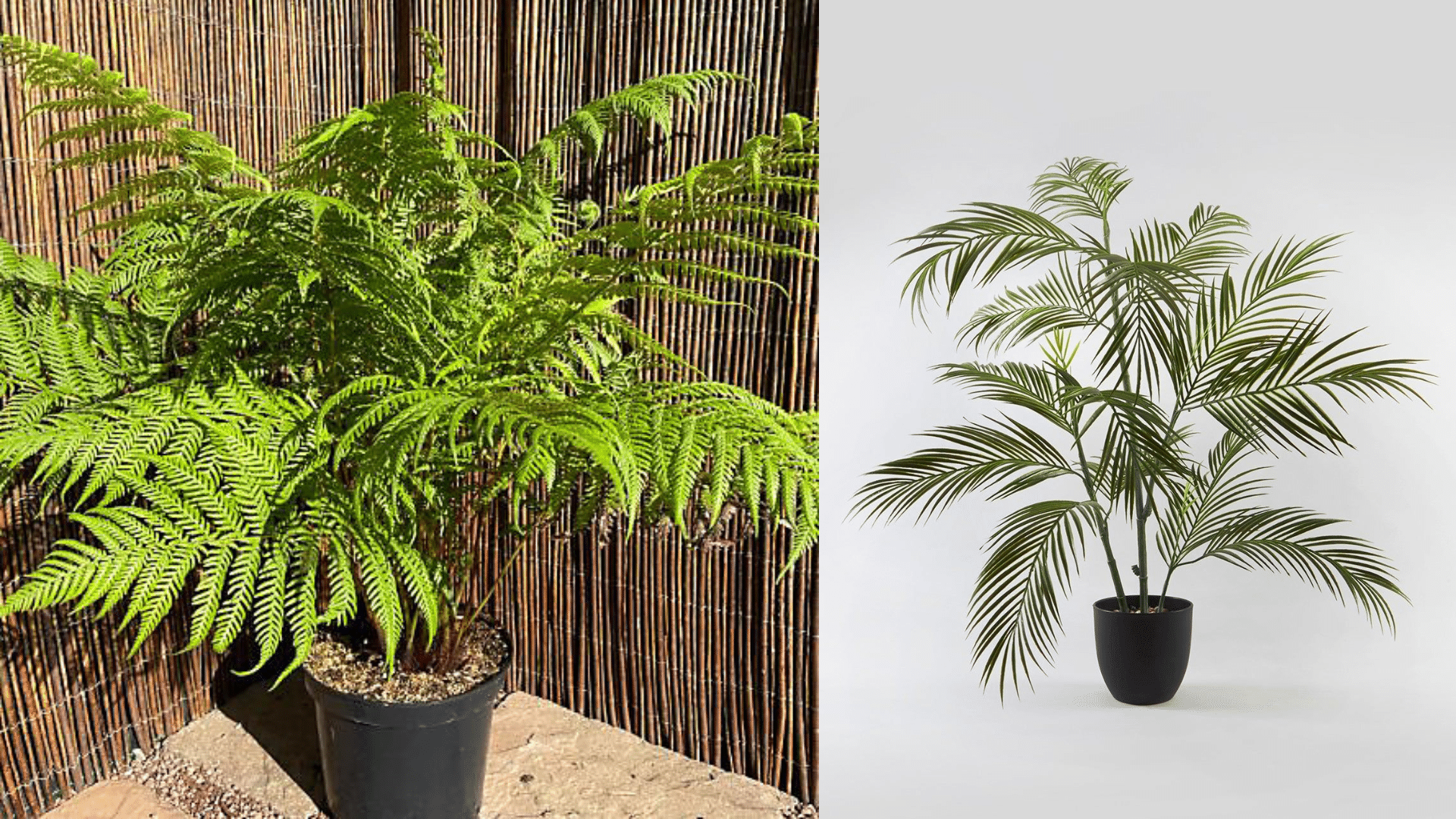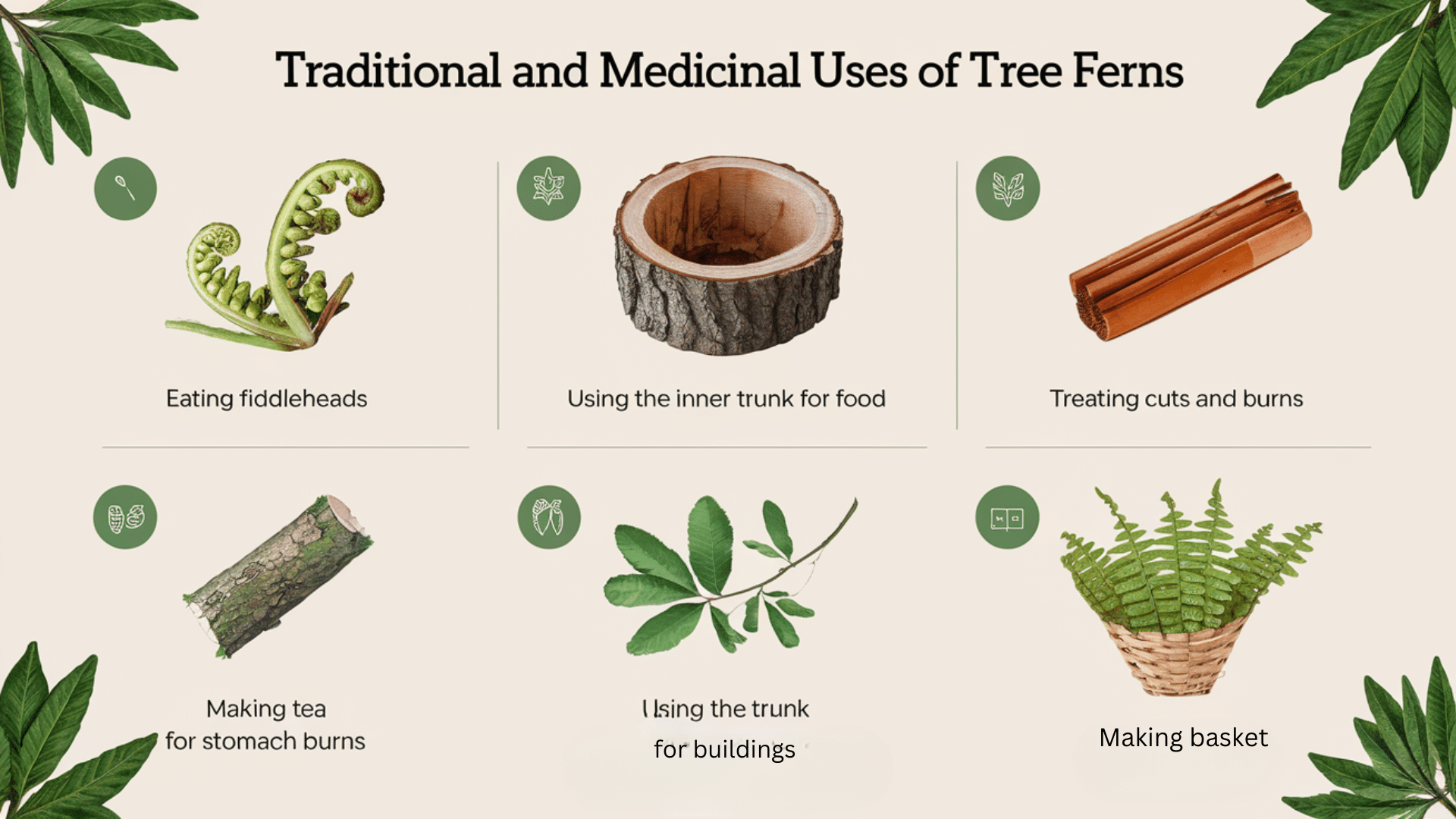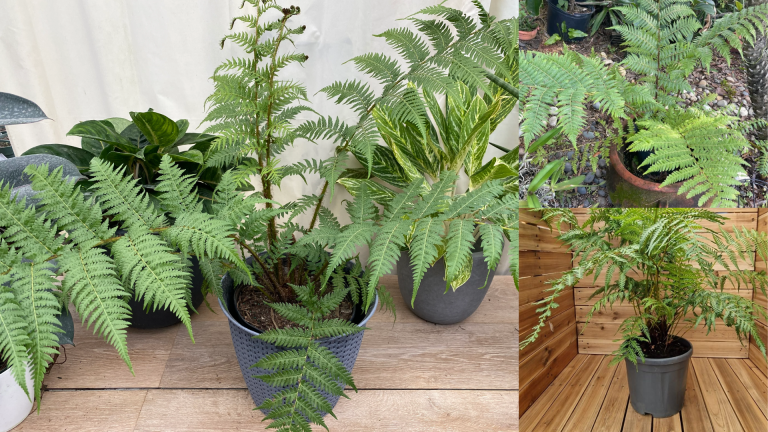Tree ferns add a touch of nature’s magic to any garden. These plants have tall stems and big, green leaves that spread out like fans.
In this blog, we’ll look at different types of tree ferns, how to care for them, and why they’re good for your garden.
You’ll learn where to plant them, how much water they need, and how to keep them safe in winter.
Tree ferns aren’t just pretty – they help our planet and have been used by people for food, medicine, and crafts for many years.
Let’s find out what makes these ancient plants so special!
Types of Tree Ferns

Tree ferns come in a variety of species, each suited to different climates and environments. Understanding the differences between them can help you choose the best option for your garden or indoor space.
Different Species
- Dicksonia antarctica (Tasmanian tree fern): Ideal for cooler, shaded areas. Features soft fronds and a strong trunk.
- Cyathea: Grows tall with long, graceful fronds. Needs a warm, tropical climate.
- Cyathea medullaris (black tree fern): Grows tall in humid areas. Perfect for creating a dramatic, tropical look.
Best Species for Various Climates
For cooler climates, Dicksonia Antarctica is a perfect choice. It thrives in shade and moderate moisture.
Cyathea species grow best in warm, tropical climates, loving the heat and humidity. For mild climates, try Cyathea dealbata (silver tree fern) for its silvery fronds.
Cyathea medullaris is ideal for tall, dramatic growth in tropical gardens.
Growing Conditions for Tree Ferns
Tree ferns make gardens look like something from the time of dinosaurs with their tall stems and big, arching leaves.
These special plants need the right care to grow well. Here’s how to help your tree ferns stay healthy.
Ideal Location
Tree ferns grow best in spots that are not in full sun. They like some shade, especially on hot afternoons. Morning sun is good, but too much strong sunlight can burn their leaves.
Keep them away from windy areas that can tear their big leaves and dry them out. Placing them on the north or east side of your house often works well.
Soil & Watering Needs
Tree ferns like rich, loose soil that drains water but stays a bit wet. To improve the soil, mix in some compost before planting.
Water them often to keep the soil damp but not too wet. The stem needs water too – spray it when it’s dry.
Tree ferns like moist air, so spray their leaves with water a few times each week, especially if you live in a dry area.
Winter Protection
When it gets cold, tree ferns need help staying warm. To this end, they wrap their stems with plant blankets or straw tied with string.
The top of the stem where new leaves grow needs the most care. Put straw around this part and tie it with cloth.
On very cold nights, cover the whole plant with a frost cloth. If you live where winters are very cold, you might want to plant tree ferns in big pots so you can move them to warmer spots.
Care and Maintenance

Taking good care of tree ferns isn’t hard, but you need to be regular with their needs. These plants need special attention to water, food, and space to grow their best and stay healthy.
1. Watering Tree Ferns
In warm weather, water your tree ferns deeply once or twice a week. Spray the trunk often to keep it damp. Water more in hot weather but less in cool weather.
Check the soil with your finger – if it feels dry an inch down, it’s time to water. Don’t let water sit at the roots, as this can cause rot. In winter, cut back on watering, but don’t let them dry out fully.
2. Fertilization & Feeding
Feed tree ferns with a weak mix of liquid plant food every month during spring and summer. Look for foods made for ferns or acid-loving plants.
Slow-release pellets work well, too – sprinkle them around the base in spring. Don’t use strong fertilizers as they can burn the roots. A layer of compost or leaf mulch on top of the soil also feeds tree ferns slowly and keeps moisture in.
3. Pruning & Repotting
Only cut off brown or dead leaves—use clean, sharp tools to avoid harm. Don’t cut green leaves, even if they look odd. Wait until spring to repot potted tree ferns.
Pick a pot just a bit bigger than the old one with good drain holes. Use fresh soil mixed with compost. When repotting, keep the trunk at the same height as before and water well afterward.
4. Common Problems
Look for brown spots on leaves, which might mean too much sun or not enough water. Small bugs like scale or mites can attack tree ferns – wash leaves with soapy water to remove them.
Black spots often mean fungus – cut off bad leaves and spray with fungus killer. Root rot from too much water shows as yellow leaves and a soft trunk – let the soil dry more between waterings.
5. Temperature & Humidity Needs
Tree ferns thrive in moderate to high humidity and cooler temperatures. They prefer a climate that’s not too hot or too cold, with temperatures ranging from 50°F to 75°F (10°C to 24°C).
If growing indoors, consider placing a humidifier nearby or misting the fern regularly to maintain the humidity it loves.
If you live in a dry climate, you may need to create a more humid environment to keep your tree fern happy and healthy.
6. Protection from Pests & Diseases
Tree ferns can attract pests like aphids, scale insects, or spider mites. To keep your fern healthy, inspect it regularly for signs of pests.
If you spot any, gently wipe the leaves with a damp cloth or spray the plant with insecticidal soap. Tree ferns can also suffer from fungal infections if exposed to too much moisture, which can cause black spots.
Always remove any affected leaves and use a fungicide to prevent further spread. Proper air circulation and avoiding overwatering can help prevent most common diseases.
Benefits of Tree Ferns
Tree ferns offer many advantages beyond just being pretty plants. They help our world, make spaces look better, and have meaning to many people.
Ecological Benefits
Tree ferns clean the air by taking in carbon dioxide and giving out oxygen. Their deep roots hold soil in place and stop it from washing away when it rains.
The area under tree ferns stays damp and makes homes for small animals and bugs. Many birds use tree ferns as safe places to build nests. These plants also help keep water in the soil, which is good for other plants nearby.
Aesthetic Value
Tree ferns, with their tall stems and wide, feathery leaves, add a lush, green look to any garden. They create a jungle or forest feel that makes gardens seem calm and old.
Their fan-like leaves make pretty shadows when the light shines through them. In homes and offices, smaller potted tree ferns bring life to empty corners and add a soft touch to hard surfaces.
They work well with both modern and classic styles.
Cultural Significance
Many native groups in New Zealand and Australia see tree ferns as signs of new life and growth. The Maori people use the tree fern shape as a key symbol in their art.
In Hawaii, tree ferns are linked to forest gods and are used in special events. Some island groups use parts of tree ferns to make food, tools, and building materials.
In modern times, the tree fern has become a symbol of ancient plants that have lived since dinosaur days.
Tree Fern Fiber and Other Uses
Tree ferns are useful for more than just making gardens pretty. For many years, people have used the fiber from their trunks and other parts of these plants in different ways.
What is Tree Fern Fiber?
Tree fern fiber comes from the outer part of the tree fern trunk. It holds water well and drains extra water away quickly.
Plant growers use it to help orchids and other air plants grow by mixing it into soil or using it alone.
The fiber breaks down slowly, so it can be used for a long time. It has small spaces that let roots get air while still holding water for them.
Traditional and Medicinal Uses

Tree ferns have been important to many groups of people for food and healing.
Tree fern parts have been used in different ways:
- Young leaves (called fiddleheads) can be cooked and eaten in some places
- The soft inner part of the trunk can be made into a flour-like food
- Some groups use tree fern parts to treat cuts, burns, and rashes
- Tea made from tree fern parts has been used to help with stomach problems
- The trunk has been cut into pieces to make walls for buildings
- Some cultures use parts of tree ferns to make baskets and other useful items
Wrapping Up
Tree ferns are amazing plants that can make your garden look special. They need some care but give back much more with their beauty and benefits.
If you want to try growing tree ferns, start with one that fits your local weather. Plant it in a spot with some shade, give it plenty of water, and protect it during cold months.
You can also use tree fern fiber for your other plants, especially orchids. These ancient plants have stood the test of time – now, they can bring a bit of nature’s history to your home.
Why not add a tree fern to your garden this season?
For more such tree and gardening-related blogs, visit our website.













